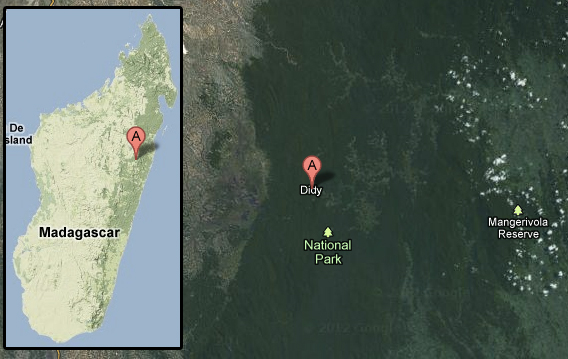
Chart: Change in peatland cover in Indonesia and Malaysia between 2000 and 2010. Background satellite image courtesy of Microsoft/Bing Maps and NASA, design by mongabay.com. Click image to enlarge.
One of Madagascar’s newest national parks has been invaded by miners following the discovery of sapphires, reports AFP.
Roughly a kilometer of forested river valley in Ankeniheny-Zahamena Reserve has been turned into a “mudpit” after wildcat miners found precious gemstones.
“We had an invasion of illegal miners in this park, which is our most recent protected area”, Angelo Francois Randriambeloson of the ministry of environment was quoted as saying. Ankeniheny-Zahamena was officially designated last year.
While the area affected is still small, other mineral and gemstone finds have had big impacts in Madagascar. For example the small town of Ilakaka in southwestern Madagascar morphed into a mining boomtown virtually overnight when sapphires were discovered in the late 1990s. Violence followed. Outside Ankarana Special Reserve in northern Madagascar, sapphire discoveries have led to incursions into the park, while similar concerns are emerging with a rise of gold mining near the renowned Ranomafana National Park. In other areas, the influx of miners has been associated with a rise in bushmeat hunting.
Given the risks, the Malagasy government says it is working to evict the miners from Ankeniheny-Zahamena.
“We are now forming a commission and we are trying to plan a way to send the people away from the mine,” said Randriambeloson. “As it’s a protected park, its soil also belongs to the Malagasy state.”
“Once the miners are out, we will restore the damage done.”
Ankeniheny-Zahamena protects a key corridor of Madagascar’s endangered eastern rainforest. The reserve is home to 15 lemur species, 89 birds, and at least 129 types of frogs. More than 2,000 species of plants have been recorded in Ankeniheny-Zahamena.
Madagascar is rich with mineral deposits but its people remain some of the poorest on Earth. In recent years, nature-based tourism has become an important source of income in many parts of the country, which is famous for its wildlife, including lemurs, colorful chameleons and geckos, and unusual plants.
Related articles